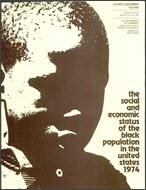The Social and Economic Status of the Black Population in the United States: 1974
The Social and Economic Status of the Black Population in the United States: 1974
Introduction
A statistical overview of the demographic, social, and economic characteristics of the black population in the United States is presented in this report, which is the eighth in the series on the subject. This study brings together the relevant data available from the Census Bureau as well as from other governmental and private agencies.
Generally, the analysis examines the recent trends (1970 to 1974) in population distribution, income, labor force, education, family composition, health, housing, voting, and other major aspects of life. Because of the severe economic recession which began in 1974, attention also has been focused on the changes in labor force and income which have occurred in 1974 and/or early 1975. Data on blacks for the subjects covered are not always available on a consistent basis for the years considered; however, the most current data are always presented.
The patterns of social and economic change which have emerged for black Americans in the 1970's are varied. Advances have been made in education, health, and in the election to public office. Progress in some other areas such as income and employment has been impeded partly as a result of the interrelationships of a number of social and economic factors such as changing family composition and work experience patterns of family members, inflation, and the downturn in the economy.
Within the last year, two of the major economic problems of our nation—inflation and economic recession—have had serious effects upon both blacks and whites. Unemployment rates have risen sharply, real income levels have been eroded, and the number in poverty has increased for whites and remained unchanged for blacks. The impact of the economic recession has been most conspicuous in the area of unemployment.
A Note on Language
Census statistics date back to 1790 and reflect the growth and change of the United States. Past census reports contain some terms that today’s readers may consider obsolete and inappropriate. As part of our goal to be open and transparent with the public, we are improving access to all Census Bureau original publications and statistics, which serve as a guide to the nation's history.
Others in Series
Publication
Publication
Publication




